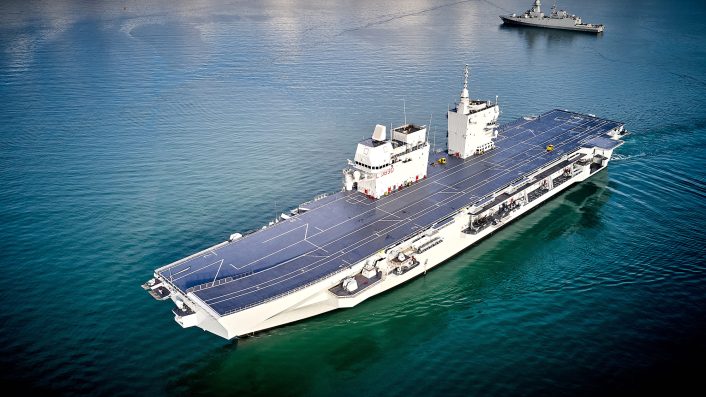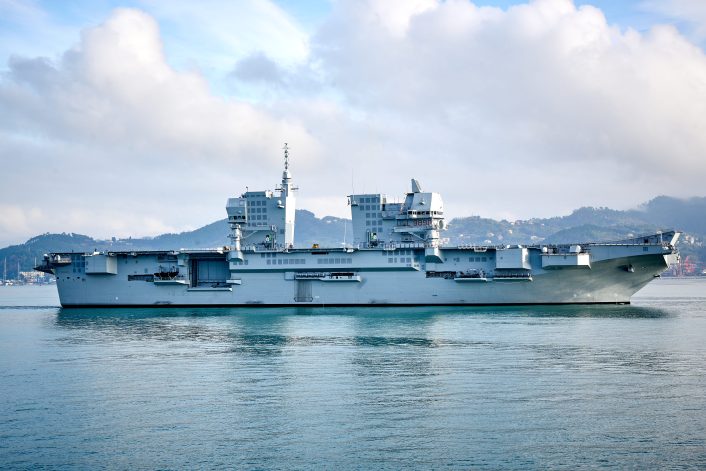Trieste is the largest combat vessel delivered to the Italian Navy since World War II.
On Dec. 7, 2024, the Italian Navy commissioned its new Landing Helicopter Dock (LHD) Trieste, the largest combat vessel built in Italy since World War II. The commissioning ceremony took place in the port of Livorno, in the presence of President Sergio Mattarella, the Minister of Defense, Guido Crosetto, the Chief of Defense Staff, General Luciano Antonio Portolano, and the Chief of Naval Staff, Admiral Enrico Credendino.
The state-of-the-art amphibious assault ship was officially handed over to the Navy during the oath of allegiance to the Italian Republic of 150 Naval Academy cadets.
#NaveTrieste è entrata a far parte della Flotta Navale della #MarinaMilitare alla presenza del Presidente della Repubblica Sergio #Mattarella.
La nuova Unità è una nave d’assalto anfibio multiruolo con capacità aerea, anfibia e sanitaria.
Dopo un intenso periodo di costruzione… pic.twitter.com/KjPUSD1Pm8
— Marina Militare (@ItalianNavy) December 7, 2024
The Trieste, was built by Fincantieri at the Castellammare di Stabia and Muggiano shipyards, and represents the culmination of a project launched nearly 14 years ago.

Minister of Defense Guido Crosetto addressed the cadets, stating:
“This ship is yours, built for you and our country. For the first time, a cadet oath is being held aboard a military vessel. The *Trieste* is the result of the work of thousands of engineers, technicians, and workers. Few nations can construct such a technological and engineering marvel. However, a ship without a crew is just a tool. You are its heart—your values, ideals, and cooperative spirit make it come alive. Today, by swearing allegiance to the Republic, you reaffirm the uniqueness and excellence of our Armed Forces. To your families, I say this: the Defense Forces are now your extended family, and they will always stand by you.”
General Portolano, Chief of Defense Staff, highlighted the Trieste’s strategic importance:
“With its delivery, the Navy gains a symbol of technological innovation and a vital asset for projecting power and deterrence. At a time marked by emerging threats to global security, especially in light of recent events in the Middle East, this ship strengthens our national defense capabilities.”
Admiral Credendino, Chief of Naval Staff, wished the new officers fair winds:
“Today, we proudly welcome the Trieste into our fleet, the largest military ship built in Italy since World War II. We chose to mark this historic moment with the solemn oath of our cadets, many of whom will grow professionally aboard this ship, achieve their ambitions, and carry out missions of strategic importance for national interests.”
Pierroberto Folgiero, CEO of Fincantieri, also celebrated the event:
“Today is a moment of great national pride. The Trieste showcases Italy’s strategic vision and manufacturing excellence. This ship not only enhances Italy’s international standing but also underscores Fincantieri’s reliability and innovation as a defense partner. I thank our workforce for their dedication and skill in achieving this milestone, and I applaud the Navy for the exemplary collaboration that symbolizes a unified national effort. The *Trieste* embodies an Italy that looks to the future with determination and ambition.”
At 245 meters in length and with a displacement of 37,500 tons, Trieste is the largest ship delivered to the Italian Navy since World War II. It features a dual-island structure, similar to the one adopted by the Royal Navy aircraft carriers. With accommodations for over 1,000 personnel, a 230-meter flight deck, and the capacity to support and project an amphibious battalion of 600 troops, Trieste is designed to handle a wide spectrum of operations. Its garage deck provides 1,200 linear meters of space for wheeled and tracked vehicles, both civilian and military.

The warship is as a Multi-Role Amphibious Unit, providing a mobile base for landing operations and force projection in crisis zones. Its internal floodable well dock enables seamless over-the-horizon deployment of significant forces in any operational environment. Beyond military tasks, its operational versatility allows it to adapt to humanitarian emergencies, making it a vital tool for disaster response.
As the flagship of the Amphibious Task Group (ATG), Trieste complements the Carrier Strike Group (CSG) led by ITS Cavour within the Expeditionary Task Force (ETF), the operational arm of the Italian naval fleet. This strategic positioning underscores Italy’s capability to project power and ensure maritime security on both national and international stages.
The ship can host command staff such as the Commander Amphibious Task Force (CATF) and the Commander Landing Force (CLF). It is equipped for over-the-horizon ship-to-shore operations (beyond 24 miles from the coast) with robust C4I (Command, Control, Communications, Computers, and Intelligence) capabilities, logistical support, and enhanced medical facilities (Role 2E). The onboard hospital includes surgical suites, radiology, laboratories, a dental clinic, and a 27-bed critical care unit, expandable with additional container-based medical assets.
The Trieste offers advanced strategic projection capabilities for both military and humanitarian missions. In emergencies, it can work with Italy’s Civil Protection Department to provide medical aid, potable water, and electrical power. The ship is also equipped for evacuating nationals and delivering humanitarian support in crisis zones.
The ship features nine spots for EH-101, NH-90, AV-8B+, F-35B, CH-53, MV-22 and CH-47.
As already made clear in the latest annual multiyear defense planning document (Documento Programmatico Pluriennale della Difesa) published in September 2024, the Italian Navy does not consider Trieste as an aircraft carrier: it is an Alternate Carrier Vessel, able to host 5th generation F-35B aircraft, enhancing the Navy’s overall operational capability. This capability reinforces Italy’s role among nations capable of effective amphibious operations, offering extensive flexibility and swift responses to modern challenges.
Dealing with the F-35B, as part of Italy’s recent order of 25 new F-35s, the Navy will get 5 additional F-35B, bringing the total to 20 aircraft.









